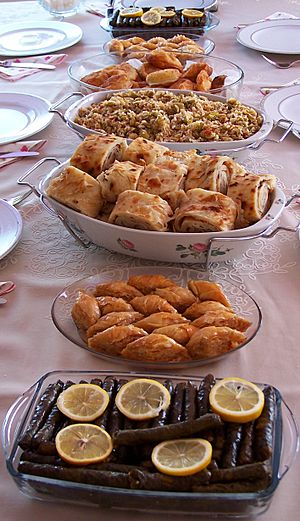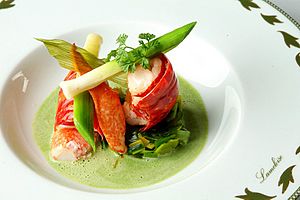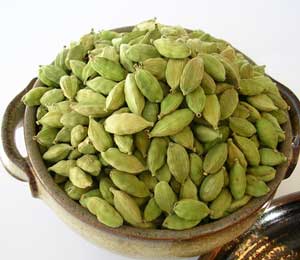Cuisine facts for kids

A cuisine is a style of cooking characterized by distinctive ingredients, techniques and dishes, and usually associated with a specific culture or geographic region. A cuisine is primarily influenced by the ingredients that are available locally or through trade.
Religious food laws, such as Hindu, Islamic and Jewish dietary laws, can also exercise a strong influence on cuisine. Regional food preparation traditions, customs and ingredients often combine to create dishes unique to a particular region.
Contents
Factors that affect a cuisine
Some factors that have an influence on a region's cuisine include the area's climate, the trade among different countries, religiousness laws and culinary culture exchange. For example, a Tropical diet may be based more on fruits and vegetables, while a polar diet might rely more on meat and fish.
The area's climate, in large measure, determines the native foods that are available. In addition, climate influences food preservation. For example, foods preserved for winter consumption by smoking, curing, and pickling have remained significant in world cuisines.
The trade among different countries also largely affects a region's cuisine. Dating back to the ancient spice trade, seasonings such as cinnamon, cassia, cardamom, ginger, and turmeric were important items in the earliest evolution of trade. Cinnamon and cassia found their way to the Middle East at least 4,000 years ago.
Culinary culture exchange is also an important factor for cuisine in many regions: Japan’s first substantial and direct exposure to the West came with the arrival of European missionaries in the second half of the 16th century. At that time, the combination of Spanish and Portuguese game frying techniques with a Chinese method for cooking vegetables in oil led to the development of tempura, the popular Japanese dish in which seafood and many different types of vegetables are coated with batter and deep fried.
History
Cuisine dates back to the Antiquity. As food began to require more planning, there was an emergence of meals that situated around culture. Rome was known for its cuisine, wealthy families would dine in the Triclinium on a variety of dishes; their diet consisted of eggs, cheese, bread, meat and honey.
New cuisines

Cuisines evolve continually, and new cuisines are created by innovation and cultural interaction. One recent example is fusion cuisine, which combines elements of various culinary traditions while not being categorized per any one cuisine style, and generally refers to the innovations in many contemporary restaurant cuisines since the 1970s.
Nouvelle cuisine (New cuisine) is an approach to cooking and food presentation in French cuisine that was popularized in the 1960s, it is a modern style of cooking which takes advantage of many technical innovations from the scientific disciplines (molecular cooking). International trade brings new foodstuffs including ingredients to existing cuisines and leads to changes.
The introduction of hot pepper to China from South America around the end of the 17th century, greatly influencing Sichuan cuisine, which combines the original taste with the taste of introduced hot pepper and creates a unique flavor of both spicy and pungent.
Global cuisine
A global cuisine is a cuisine that is practiced around the world, and can be categorized according to the common use of major foodstuffs, including grains, produce and cooking fats.
Regional cuisines
Regional cuisines may vary based upon food availability and trade, cooking traditions and practices, and cultural differences. For example, in Central and South America, corn (maize), both fresh and dried, is a staple food. In northern Europe, wheat, rye, and fats of animal origin predominate, while in southern Europe olive oil is and rice is more prevalent. In Italy the cuisine of the north, featuring butter and rice, stands in contrast to that of the south, with its wheat pasta and olive oil.
China likewise can be divided into rice regions and noodle & bread regions. Throughout the Middle East and Mediterranean there is a common thread marking the use of lamb, olive oil, lemons, peppers, and rice. The vegetarianism practiced in much of India has made pulses (crops harvested solely for the dry seed) such as chickpeas and lentils as significant as wheat or rice. From India to Indonesia the use of spices is characteristic; coconuts and seafood are used throughout the region both as foodstuffs and as seasonings.
Related pages
Images for kids
-
An example of Central European cuisine, the Wiener Schnitzel. It is prepared with regional ingredients and according to the local cooking style.
-
Typical Ethiopian and Eritrean cuisine: Injera (thin pancake-like bread) and several kinds of wat (stew)
-
Yassa is a popular dish throughout West Africa prepared with chicken or fish. Chicken yassa is pictured.
-
Due to Guangdong's location on the southern coast of China, fresh live seafood is a specialty in Cantonese cuisine. Such markets selling seafood are found across East Asia.
-
Traditional North Indian vegetarian thali with various curries from India. Various curry dishes are found across South Asia.
-
A market stall at Thanin market in Chiang Mai, Thailand, selling ready-cooked food. Market stalls selling food are found across Southeast Asia.
-
A Tajik feast. A large feast is commonly associated with cultures of Central Asia.
-
An English Sunday roast with roast beef, roast potatoes, vegetables and Yorkshire pudding
-
A variety of tapas: appetizers or snacks in Spanish cuisine
-
Beef Stroganoff, a Russian dish.
-
Bush Tucker (bush foods) harvested at Alice Springs Desert Park in Australia
-
A Hāngi being prepared, a New Zealand Māori method of cooking food for special occasions using hot rocks buried in a pit oven.
-
Bandeja paisa from Peñól de Guatapé in Antioquia, Colombia.
-
A Jamaican patty wrapped in coco bread.
-
Buffalo wings with blue cheese dressing, served with lager beer.
See also
 In Spanish: Cocina (tradiciones) para niños
In Spanish: Cocina (tradiciones) para niños























